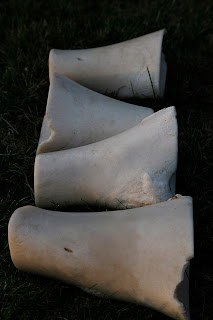I find it most strange that we should describe colour temperature by the shades of hot iron and then measure it in degrees Kelvin! This gives us a level of temperature that is quite inappropriately high for something as delicate as photography and in a scale that is usually the province of physicists. However, the foibles of photographic history aside it might just as well be Kelvin as Bananas as there are plenty of other strange scales which we use and it is just a measure after all.
With the camera White Balance set to Daylight this exercise asked us to take images in midday sunshine, midday shade and with a low sun... in my case sunset. The results are below:
Noon Sunlight
Noon Shade
Low Sunlight
The results are very much as expected. The direct sunlight shot shows completely neutral colours in that my grey mottled mannequin head looks exactly as it does to the eye. The other noon shot displays what was difficult for me to note with by eye in that is has a distinct blue cast. The evening shot was more noticeable because as I set it up I could already see that the low sun was tending towards orange and that colouration would naturally transfer to the photograph. Indeed, it has a distinct orange/red tint.
PART 2
Looking at the previous exercise I definitely prefer the colour obtained in Noon Sunlight as I rarely think a colour cast improves an image unless it can, for example, compliment colour or add to atmosphere. Certainly the blue cast of Noon Shade is not an unpleasant colour and the orange of Low Sunlight also acceptable but neither of them looks at all natural and don't suit the subject.
The second practical part of this exercise asked us to repeat the set up but this time shooting three versions of a subject in White Balance settings Daylight, Shade and Auto.
PART 2
Looking at the previous exercise I definitely prefer the colour obtained in Noon Sunlight as I rarely think a colour cast improves an image unless it can, for example, compliment colour or add to atmosphere. Certainly the blue cast of Noon Shade is not an unpleasant colour and the orange of Low Sunlight also acceptable but neither of them looks at all natural and don't suit the subject.
The second practical part of this exercise asked us to repeat the set up but this time shooting three versions of a subject in White Balance settings Daylight, Shade and Auto.
Sun with WB Daylight
Sun with WB Shade
Sun with WB Auto
The settings for these 3 images has the Daylight and Auto photos looking fairly similar, auto being slightly bleached out but shooting with Shade set has given a distinct orange cast.
Shadow with WB Sunlight
Shadow with WB Shade
Shadow with WB Auto
Here taking the same 3 photos in shadow shows that the pre-sets for light conditions are probably the most accurate rendition of the subject. Compare Shadow with WB Shade to Sun with WB Daylight and they are remarkably similar. My only other comment is that the actual bones are quite a plain creamy hue with very little yellow/brown colouring so the most accurate image so far (with respect to colour) is Shadow with WB Auto.
Sunset with WB Daylight
Sunset with WB Shade
Sunset with WB Auto
Finally, shooting at sunset one would expect the photos to have the usual orange tint that a setting sun delivers which is what we get with the WB settings at Daylight and more so with Shade but what I didn't expect was the more accurate colour that Auto gave. This is an interesting result as Auto seems to have corrected well for all light conditions. So despite making the effort to manually set the White Balance of my camera I have achieved a more accurate representation with the 'coverall' automatic settings.













No comments:
Post a Comment